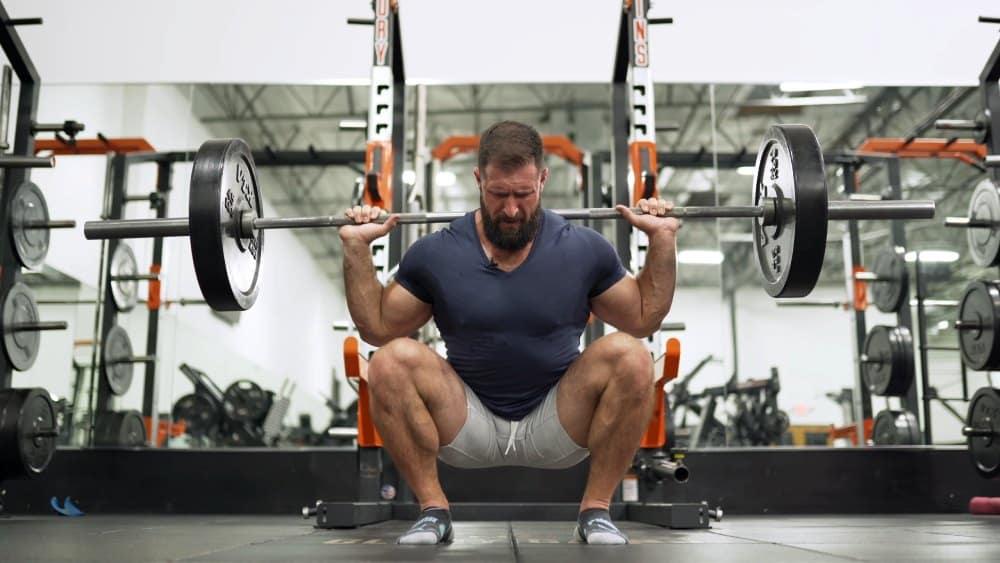Today we dive deep into the average squat weight for men and women.
Discover squat standards by strength level and the bodyweight-to-squat weight ratio. Learn strategic training tips, one-rep max calculations, and comparisons with other lifts. Dive into the world of squat world records and recovery strategies to maximize your gains.
Related: Find the average overhead press, deadlift and bench press weights (how do you compare)?
Let’s get to it:
Jump to:
- Determining Your Average Squat Weight
- Squat Standards by Strength Level
- Squatting for Different Populations
- Weight Categories in Squat Performance
- Understanding Squat Mechanics
- Training and Progression Strategies
- Calculating One-Rep Max
- Comparison to Other Lifts
- World Records and Notable Achievements
- Training Frequency & Recovery
- References:
Determining Your Average Squat Weight
Factors Influencing Squat Weights
Gender and age play significant roles in determining the average squat weight you can lift. Generally, men have higher average squat weights due to factors such as muscle mass and testosterone levels.
The average squat weight is usually categorized by weight classes and experience levels to provide more tailored reference points.
For women, the average squat weight can be affected by lower levels of muscle mass and different hormonal influences. It’s crucial to consider these physiological differences when comparing squat standards across genders.
- Beginners might start with lighter weights to focus on form and safety.
- Intermediate lifters often progress to lifting their body weight or more.
- Advanced and elite athletes might squat much more than their body weight.
Interpreting Average Squat Data
Average squat data usually stems from various sources like fitness assessments of a broad population or from specific studies, such as the ones focused on the effects of weight-training programs, which consider the maximum weights lifted in particular exercises.
When looking at the results from the studies involving the load on the knee joint or the relationship between squat strength and balance, it’s essential to understand these are isolated scenarios that might differ from general gym-going populations.
- Weight classes: Heavier individuals tend to lift more absolute weight, but when considering weight relative to one’s body, this may not hold true.
- Experience levels: Novice lifters generally lift approximately 60% of their body weight, while experienced lifters may squat 1-1.5 times their body weight, and some elite athletes even more.
Remember, average squat weights are generalized figures; your personal squat weight should be tailored to your specific capacity and fitness goals.
Squat Standards by Strength Level
Squatting is a fundamental exercise that helps you gauge your lower-body power and overall strength. The standards for squat strength can vary considerably based on your training level.
Novice to Advanced Classification
When you first start squatting, your initial strength is considered novice. At this stage, your main goal is to build a foundation. As you progress, your squat weight standard will evolve.
- Novice: Typically within the first few months of training, the goal is consistent improvement.
- Intermediate: After a year or so, you’re expected to squat greater weights with proper technique.
- Advanced: Achieved after several years of dedicated training, indicating significantly higher strength and technique.
The progress from novice to advanced levels of strength is a steady journey, and it’s important to ensure you’re lifting challenging yet manageable weights to promote consistent muscle growth and strength gains.
Elite Strength Benchmarks
Elite strength, however, is a tier that separates serious lifters from the rest. This status is not just about lifting heavy weights—it is about lifting at the peak levels for your body weight.
To be considered elite, you not only have surpassed the advanced level but also are competitive in strength sports such as powerlifting. Here’s an example of what elite squat standards might look like for different weights:
- Male (198 lbs class): Squatting more than 500 lbs
- Female (148 lbs class): Squatting more than 300 lbs
These benchmarks are exceptional, representing strength that’s attained through years of strategic and disciplined training. Remember that these numbers can vary between different organizations and should serve as general guidelines to aspire towards, not absolute measures of one’s strength level.
Squatting for Different Populations
When you consider squatting, it’s important to understand that male and female lifters often have different standards due to physiological differences and varying objectives in training.
Male Lifter Standards

For male lifters, standards for squat weights are typically categorized by body weight and experience level. As an example, an adult man who weighs 165 pounds and is a novice might squat around 135 pounds, whereas a more experienced lifter at the same weight could be squatting upwards of 295 pounds.
Athletes often aim higher, pushing these numbers up as their strength and conditioning improve.
Here is a basic table illustrating average squat standards for adult men, based on body weight:
| Body Weight (lbs) | Novice (lbs) | Intermediate (lbs) | Advanced (lbs) | Elite (lbs) |
|---|---|---|---|---|
| 135 | 105 | 200 | 320 | 410 |
| 165 | 135 | 245 | 355 | 455 |
| 198 | 160 | 290 | 410 | 520 |
| 220+ | 175 | 320 | 460 | 585 |
Female Lifter Standards

In contrast, female lifters have their own set of squat standards that recognize the differences in muscle mass and strength due to factors such as hormonal composition and body structure. For instance, a novice lifter who is an adult woman weighing 135 pounds may typically squat around 95 pounds, while an intermediate could handle 175 pounds. Female athletes might squat even more as their training intensifies and they gain more experience.
Here’s a snapshot of average squat standards for adult women, categorized by body weight:
| Body Weight (lbs) | Novice (lbs) | Intermediate (lbs) | Advanced (lbs) | Elite (lbs) |
|---|---|---|---|---|
| 105 | 80 | 150 | 205 | 265 |
| 135 | 95 | 175 | 240 | 310 |
| 165 | 110 | 200 | 275 | 355 |
| 198 | 120 | 225 | 305 | 395 |
Bear in mind that age and weight play significant roles in determining what can be considered average or standard squats for men and women. Your goals, training regimen, and whether you’re lifting for general fitness or competition will all influence these numbers.
Weight Categories in Squat Performance
When assessing squat performance, your body weight and the amount of weight you can squat (squat weight) are essential factors. They determine your body weight to squat weight ratio and help to differentiate between absolute and relative strength in both pounds (lb) and kilograms (kg).
Bodyweight to Squat Weight Ratio
Your bodyweight to squat weight ratio is a key indicator of your strength and performance. This ratio helps gauge how much weight you can lift in comparison to your own body weight. Generally, a healthy ratio varies depending on several factors, including your gender, age, and experience level. For men, a common goal for a squat is to lift approximately 1.5 to 2 times their body weight, while women might aim for a squat that’s roughly 1 to 1.5 times their body weight.
Absolute vs. Relative Strength
Absolute strength refers to the total amount of weight you can squat without considering your body weight. In contrast, relative strength measures your squat weight relative to your body weight. This is particularly important in understanding your performance within various weight categories:
- Lightweight: Squat weights are often lower, but relative strength can be high if you can squat significantly more than your body weight.
- Middleweight: There’s frequently a balance between squat weight and body weight, aiming for optimal performance.
- Heavyweight: Squat weights tend to be the highest, but relative strength might be lower if the increment in squat weight doesn’t proportionally exceed the body weight increase.
To illustrate, if you weigh 160 lb (approx. 72.5 kg) and can squat 240 lb (approx. 108.8 kg), your body weight to squat weight ratio is 1.5, reflecting your relative strength in this context.
Understanding Squat Mechanics
When performing a squat, the efficacy of the exercise and your safety hinge upon your execution of proper form, awareness of safety considerations, and the mobility work that facilitates full range of motion.
Proper Form and Technique
To maximize the benefits of squats and minimize the risk of injury, attention to proper technique is crucial. Stand with your feet shoulder-width apart, toes slightly pointed outward. Maintain a neutral spine as you hinge at your hips and bend your knees to lower your body. It’s vital to keep your knees in line with your feet without them collapsing inward or tracking too far past your toes. Ascend by driving through your heels, keeping your chest up and core engaged.
Safety Considerations
Safety during squats is non-negotiable. Begin with a weight appropriate to your fitness level, and increase load gradually. It’s essential to use a squat rack with safety bars set at an adequate height to catch the barbell should you need to drop it. Always have a spotter present when attempting heavy lifts. Recognize the signs of overexertion, such as a loss of form, to reduce the chances of injury.
Mobility and Warm-Up Exercises
Before doing squats, incorporate dynamic stretches and warm-up exercises to prepare your muscles and joints. Activities like leg swings, hip rotations, and bodyweight lunges enhance your mobility, promoting a greater range of motion and reducing stiffness. Warming up increases blood flow to the muscles, thus reducing the risk of strains or sprains during your squat session.
Training and Progression Strategies
Effective training and progression strategies are essential in achieving your squat strength goals. A tailored approach considering your experience level and fitness goal ensures steady progression and prevents plateaus.
Setting Realistic Fitness Goals
Initiate your journey by defining realistic fitness goals. If you’re a beginner, start with mastering the form with lighter weights, and gradually increase the load. Your goal could be to squat a specific weight or to improve overall leg strength. For example, an intermediate lifter could aim for a squat that is 1.5 times their body weight. Remember, goals should be SMART: Specific, Measurable, Achievable, Relevant, and Time-bound.
Structured Workout Routines
Your workout should be structured to not only optimize progression in weight but also in reps and sets. If you’re just starting, focus on higher reps (about 12-15) with lighter weights to build endurance and form. Progress to intermediate with moderate weights and reps (8-12). For advanced lifters, heavier weights with lower reps (4-6) can help in strength building. Each workout should consist of at least 3-5 sets to sufficiently stimulate muscle growth and strength gains.
Remember to adjust your workouts to your growth, periodically increasing the weights while keeping in line with your set and rep goals. A proven strategy, such as the progressive overload principle, can guide you to safely increase the intensity of your workouts over time. This principle is fundamental in propelling both novice and experienced lifters toward their fitness goals.
Calculating One-Rep Max
Calculating your one-rep max (1RM) is essential for measuring the maximum weight you can squat for one repetition. It’s a benchmark for strength and a baseline to set training intensities.
1RM Estimation Formulas
Various formulas can estimate your 1RM without needing to perform a maximum lift, which can be risky. Two well-known equations include the Epley formula and the Brzycki formula:
- Epley Formula: Estimated 1RM = Weight Lifted × (1 + (0.0333 × Number of Reps))
- Brzycki Formula: Estimated 1RM = Weight Lifted × (36 / (37 – Number of Reps))
These formulas require you to know the maximum number of repetitions you can do with a certain weight. By using these, you can approximate your squat 1RM in pounds.
Practical Applications for 1RM
Knowing your estimated squat 1RM aids in creating effective training programs. For example, if your goal is to increase strength, you could train at a high intensity, typically between 70-85% of your 1RM. To develop power, training with 50-70% of your 1RM with an explosive tempo could be beneficial.
Using your 1RM, you can also track your progress over time, ensuring that your training leads to tangible increases in the maximum weight you can lift. It’s crucial to retest your 1RM periodically as it can change with training.
Comparison to Other Lifts
When evaluating your strength training regimen, it’s essential to consider how different lifts compare in terms of muscle force production. Your average squat weight is not an isolated metric; it can be instructional to assess it relative to other compound exercises like deadlifts and bench presses.
Squat vs. Deadlift
Squat: Primarily targets your quadriceps, hamstrings, and glutes.
- Average Weight Lifted: Can vary based on gender, with findings suggesting that women may lift more relative to their body weight in the squat compared to men.
Deadlift: Engages a similar muscle group but with a stronger emphasis on your posterior chain, including your lower back, glutes, and hamstrings.
- Gender Variance: Men typically lift heavier absolute weights in the deadlift, which can sometimes eclipse their squat weights due to the biomechanical advantages inherent in deadlifting.
- Relative Strength: It’s common for your deadlift numbers to exceed your squat numbers, reflecting the different mechanics and muscle involvements of these lifts.
Squat vs. Bench Press
Squat:
- Total Muscle Engagement: Considered a full-body movement stimulating a wide array of muscle groups.
Bench Press:
- Upper Body Focus: Specifically targets your pectorals, deltoids, and triceps.
- Comparative Weight: Generally lower than squat weights, as the bench press is an upper-body exercise and your lower body can typically handle heavier loads.
- Gender Differences: While both men and women will usually bench press less than they squat, the gap between the exercises might be more pronounced for men due to typically greater upper body mass and strength.
Remember to evaluate these comparisons within the context of your personal fitness goals and ability levels.
World Records and Notable Achievements
In the realm of strength sports, squat world records are a testament to human physical potential. These achievements are often seen as benchmarks of progress within the powerlifting community.
Men’s Squat World Records
In men’s categories, the squat world records differ across weight classes and federations. However, an American male powerlifter might hold a record with a squat exceeding 1000 pounds, setting a standard for strength that is recognized worldwide.
- Under 59 kg: Record squat of 390.5 kg
- Under 120 kg: Record squat of 480 kg
Women’s Squat World Records
For women, the records are equally impressive, showcasing incredible strength and determination. Women in lighter weight classes can squat more than triple their body weight, and the numbers continue to grow as competitors push the boundaries.
- Under 52 kg: Record squat of 210 kg
- Open category: Record squat of 272.5 kg
Athletes from around the globe strive to leave their mark in this competitive arena by lifting weights that were once thought impossible.
Training Frequency & Recovery
Incorporating optimal training frequency and recovery strategies is crucial for maximizing your squat strength. Tailoring your workout schedule and employing effective healing techniques ensures continued progress and minimizes injury risk.
Squat Workout Scheduling
Your squat workout frequency should align with your fitness level and goals. Beginners may benefit from squatting twice a week, allowing ample recovery time between sessions. As you become more advanced, you might increase to a frequency of three times per week, as this can facilitate further strength gains. It’s important to note that studies have shown different back squats can impact lifting velocity recovery in resistance-trained individuals.
- Beginners: 2 sessions/week
- Intermediate to Advanced: 3 sessions/week
Consistent progression often requires balancing workout intensity and frequency to prevent overtraining.
Recovery and Healing Techniques
Recovery is a fundamental aspect of any training program, especially after high-intensity exercises like squats. Immediately following a squat session, simple bodyweight squats can support active recovery by enhancing blood flow to the muscles. For optimal healing, integrate recovery days into your workout routine, allowing 48 hours between intense lower-body workouts. Resistance training intensity can influence sleep quality, a critical component of muscle healing.
- Active Recovery: Light exercises (e.g., bodyweight squats)
- Rest: Minimum 48 hours between intense squat sessions
- Sleep: Quality and duration are vital for strength recovery
Incorporating resistance training with different workout frequencies has been shown to have an effect on muscle mass and strength in untrained individuals, suggesting the importance of tailored recovery periods.
References:
- STONE, MICHAEL H.1; POTTEIGER, JEFF A.2; PIERCE, KYLE C.3; PROULX, CHRIS M.1; O’BRYANT, HAROLD S.1; JOHNSON, ROBERT L.1; STONE, MEG E.1. Comparison of the Effects of Three Different Weight-Training Programs on the One Repetition Maximum Squat. Journal of Strength and Conditioning Research 14(3):p 332-337, August 2000.
- Hartmann, H., Wirth, K. & Klusemann, M. Analysis of the Load on the Knee Joint and Vertebral Column with Changes in Squatting Depth and Weight Load. Sports Med 43, 993–1008 (2013). https://doi.org/10.1007/s40279-013-0073-6
- McCurdy, Kevin, and George Langford. “The relationship between maximum unilateral squat strength and balance in young adult men and women.” Journal of sports science & medicine vol. 5,2 282-8. 1 Jun. 2006














